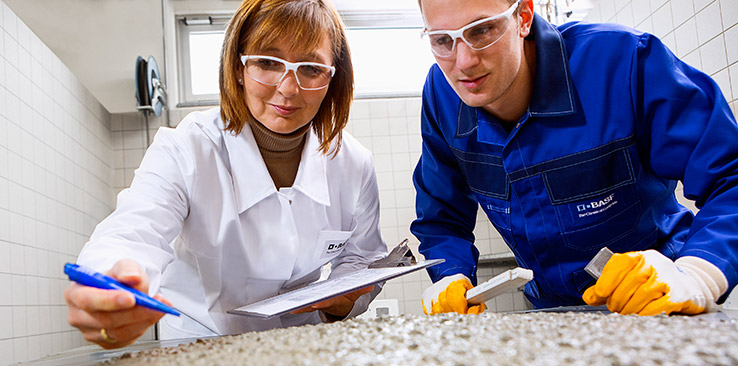BASF Innovations

Photo: Two employees in the Construction Chemicals division examine the rheological properties of freshly mixed concrete in the lab. MasterEase® reduces its viscosity by up to 30%.
Getting into the flow with MasterEase® concrete admixtures
The flow properties of concrete are a major factor in how efficiently work can progress at a construction site. Our new polymers in the MasterEase® range of concrete additives increase fluidity, making processing considerably easier – especially for challenging construction projects with demanding technical requirements.
Saving resources with additives
Concrete is a course, viscous mixture that demands great amounts of work, energy and resources to both produce and process. The use of additives like MasterEase® improves how the components interact: Cement provides the binding action while water allows the concrete to react and flow. Admixtures make it possible to considerably reduce the proportion of water needed, while cement – the most expensive raw material, whose production requires great amounts of energy and releases a lot of CO2 – can also be replaced with energy-efficient alternatives like blast-furnace slag or fly ash. This makes concrete more economical and improves its environmental profile.
Fluidity: a key factor
The high viscosity of low-water concrete mixtures can prove problematic for further processing steps. Our patented polymers in the MasterEase® range of additives reduce viscosity by up to 30% compared with previously available products, making the concrete significantly more workable, even when resources are used sparingly.
Combined action
MasterEase® is based on the innovative generation of poly aryl ether (PAE) polymers, hybrids that combine different types of monomers. In the past, these monomers had been deployed separately, each delaying the reaction between concrete components in its own way. The hybrid polymers in MasterEase® pool the talents of these individual monomers, making the additive even more effective at keeping the concrete from binding and becoming viscous too early.
Flexible use
There are additional advantages for both production and processing: Easier pumping and reduced wear and tear on equipment mean fewer costs and less energy use; laying the concrete goes faster; and surface finishing is simpler. This provides challenging construction projects in particular with the increased flexibility to fulfill demanding technical requirements.